Statements : The effectivenss of catlyst has found more applications is solid catlyst and gaseous reactant systems .
Explanations : A large number of industrial rpeparation are based on this type fo reaction .
S is correct but E is wrong .
S is worong but E is correct
Both S and E are correct and E is correct explanation of (S) .
Both S and E are correct but E is not correct explanation of S.
The correct Answer is:C
Explanation is correct reason for statement .
Topper's Solved these Questions
Similar Questions
(a) The decomposition of A into products has a value of K as 4.5×103s−1 at 10∘C and energy of activation 60kJ mol−1. At what temperature would K be 1.5×104s−1 ?
(b) (i) If half life period of a first order reaction is x and 3/4th life period of the same reaction is y, how are x and y related to each other ?
(ii) In some cases it is found that a large number of colliding molecules have energy more than threshold energy, yet the reaction is slow. Why?View SolutionRead the passage given below and answer the question:
Industrially widely applied esterification reactions are commonly catalysed using mineral liquid acids, such as sulphuric acid and p-toluenesulphonic acid. The catalytic activity of homogeneous catalysts is high. They suffer, however, from several drawbacks, such as their corrosive nature, the existence of side reactions, and the fact that the catalyst cannot be easily separated from the reaction mixture. The use of solid acid catalysts offers an alternative and has received a lot of attention in the past years. Solid acid catalysts are not corrosive and, coated onto a support, they can be easily reused. Examples of solid acid catalysts used in esterification reactions include ion-exchange resins, zeolites and superacids like sulphated zirconia and niobium acid. Ion-exchange resins are the most common heterogeneous catalysts used and have proven to be effective in liquid phase esterification and etherification reactions. Because of their selective adsorption of reactants and swelling nature, these resins not only catalyse the esterification reaction but also affect the equilibrium conversion. Shortcomings include insufficient thermal resistance, which limits the reaction temperature to 120∘C, preventing widespread use in industry. Zeolites, like Y, X, BEA, ZSM-5 and MCM 41 offer an interesting alternative and have proven to be efficient catalysts for esterification reactions. Zeolites have found wide application in oil refining, petrochemistry and in the production of fine chemicals. Their success is based on the possibility to prepare zeolites with strong Brønsted acidity that can be controlled within a certain range, combined with a good resistance to high reaction temperatures.
In this study, the activity of various commercial available solid acid catalysts is assessed with respect to the esterification of acetic acid with butanol. The ion-exchange resins Amberlyst 15 and Smopex-101, the acid zeolites H-ZSM-5, H-MOR, H-BETA and H-USY, and the solid superacids sulphated zirconia and niobium acid are selected. Comparative esterification experiments have been carried out using the homogeneous catalysts sulphuric acid, p toluenesulphuric acid and a heteropolyacid (HPA). The weight-based activity of the heterogeneous catalysts tested is maximum for Smopex 101. The following table gives the activity of different catalysts in the esterification reaction between acetic acid and butanol at 75∘C.
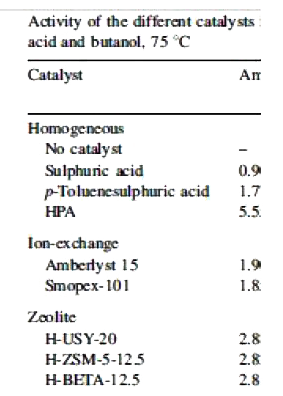
Here: kobs : observed reaction rate constant (m3mol−1s−1) kc catalysed reaction rate constant (m3mol−1g−1cats−1) Please note: k c = k obs/ amount (in g)
(source: PETERS, T., BENES, N., HOLMEN, A., & KEURENTJES, J. (2006). Comparison of commercial solid acid catalysts for the esterification of acetic acid with butanol. Applied Catalysis A: General, 297(2), 182-188. doi:10.1016/j.apcata.2005.09.00)
Catalysts used in oil refining industry are:View Solution
Knowledge Check
- Question 1 - Select One
Read the passage given below and answer the question:
Industrially widely applied esterification reactions are commonly catalysed using mineral liquid acids, such as sulphuric acid and p-toluenesulphonic acid. The catalytic activity of homogeneous catalysts is high. They suffer, however, from several drawbacks, such as their corrosive nature, the existence of side reactions, and the fact that the catalyst cannot be easily separated from the reaction mixture. The use of solid acid catalysts offers an alternative and has received a lot of attention in the past years. Solid acid catalysts are not corrosive and, coated onto a support, they can be easily reused. Examples of solid acid catalysts used in esterification reactions include ion-exchange resins, zeolites and superacids like sulphated zirconia and niobium acid. Ion-exchange resins are the most common heterogeneous catalysts used and have proven to be effective in liquid phase esterification and etherification reactions. Because of their selective adsorption of reactants and swelling nature, these resins not only catalyse the esterification reaction but also affect the equilibrium conversion. Shortcomings include insufficient thermal resistance, which limits the reaction temperature to 120∘C, preventing widespread use in industry. Zeolites, like Y, X, BEA, ZSM-5 and MCM 41 offer an interesting alternative and have proven to be efficient catalysts for esterification reactions. Zeolites have found wide application in oil refining, petrochemistry and in the production of fine chemicals. Their success is based on the possibility to prepare zeolites with strong Brønsted acidity that can be controlled within a certain range, combined with a good resistance to high reaction temperatures.
In this study, the activity of various commercial available solid acid catalysts is assessed with respect to the esterification of acetic acid with butanol. The ion-exchange resins Amberlyst 15 and Smopex-101, the acid zeolites H-ZSM-5, H-MOR, H-BETA and H-USY, and the solid superacids sulphated zirconia and niobium acid are selected. Comparative esterification experiments have been carried out using the homogeneous catalysts sulphuric acid, p toluenesulphuric acid and a heteropolyacid (HPA). The weight-based activity of the heterogeneous catalysts tested is maximum for Smopex 101. The following table gives the activity of different catalysts in the esterification reaction between acetic acid and butanol at 75∘C.
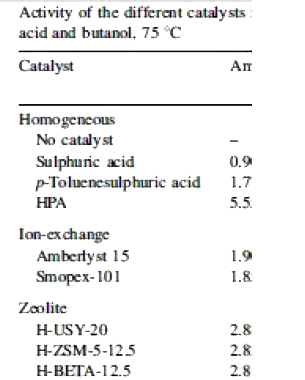
Here: kobs : observed reaction rate constant (m3mol−1s−1) kc catalysed reaction rate constant (m3mol−1g−1cats−1) Please note: k c = k obs/ amount (in g)
(source: PETERS, T., BENES, N., HOLMEN, A., & KEURENTJES, J. (2006). Comparison of commercial solid acid catalysts for the esterification of acetic acid with butanol. Applied Catalysis A: General, 297(2), 182-188. doi:10.1016/j.apcata.2005.09.00)
Which of the following are heterogeneous catalysts for esterifctaion reaction:Asulphuric acid and p-toluenesulphonic acidBsulphuric acid and niobium acidCp-toluenesulphonic acid and niobium acidDniobium acid and sulphated zirconia - Question 2 - Select One
For a sponaneous reaction, the free energy change must be negative, ΔG=ΔH−TΔS,ΔH is the enthalpy change during the reaction. T is the absolute temperature, and ΔS is the change in entropy during the reaction. Consider a reaction such as the formation of an oxide
M+O2→MO
Dioxygen is used up in the course of this reaction. Gases have a more random structure (less ordered) than liquid or solids. Consequently gases have a higher entropy than liquids and solids. In this reaction S (entropy or randomness) decreases, hence ΔS is negative. Thus, if the temperature is raised then TΔS becomes more negative,Since, TΔS is substracted in the equation, then ΔG becomes less negative. Thus, the free energy change increases with the increase in temperature.
The free energy changes that occur when one mole of common reactant (in this case dioxygen) is used may be plotted graphically aginst temperature for a number of reactions of metals to their oxides. The following plot is called an Ellingham diagram for metal oxide. Understanding of Ellingham diagram is extremely important for the efficient extraction of metals.
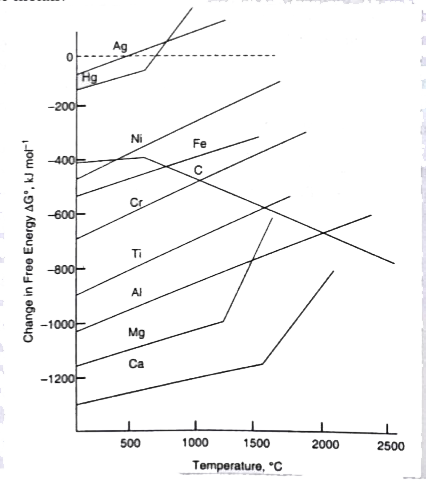
Free energy change of Hg and Mg for the convertion to oxides the slpe of ΔG vsT has been changed above the boiling points of the given metal because :Aabove the boiling point of the metal entropy is increasedBabove the boiling point of the metal the entropy is decreasedCabove the boiling point of the metal the entropy change is equal to zeroDAll of these - Question 3 - Select One
The activity of a catalyst has been explained in terms of spontaneous adsorption of reactant moleculse on the surface of catlyst and ther by forming an activated adsorbed complex along with evolution of heat . The adorbed activated complex undergoes to decompositio to regencerate catlyst and give products . adorpton is of two types :
(i) Physical adsorptio due to van der Waal's forces of attraction between reactant and catalyst molecules , weak , less exothermic, mulitlay and non-dirctional .
(ii) Chemical dasorpton due to free valencies , strong, more exothermic, unilayer. The extent of adormpotion (x/m) vs temperature at constant pressure gives isobars. Freundilish studied influence of pressure on the phusical adorptons and reported that log xmlogK+1nlogP.
The graph platted between log xm vs log P was found to be a straight line . The slope and intercept of line leass for 1n and log K values . find the wrong statement .AThe relation holds good at average pressureBThe relation fails in case of chemical adsorptionCAt very low pressure n=1Dnone of these
Read the passage given below and answer the question:
Industrially widely applied esterification reactions are commonly catalysed using mineral liquid acids, such as sulphuric acid and p-toluenesulphonic acid. The catalytic activity of homogeneous catalysts is high. They suffer, however, from several drawbacks, such as their corrosive nature, the existence of side reactions, and the fact that the catalyst cannot be easily separated from the reaction mixture. The use of solid acid catalysts offers an alternative and has received a lot of attention in the past years. Solid acid catalysts are not corrosive and, coated onto a support, they can be easily reused. Examples of solid acid catalysts used in esterification reactions include ion-exchange resins, zeolites and superacids like sulphated zirconia and niobium acid. Ion-exchange resins are the most common heterogeneous catalysts used and have proven to be effective in liquid phase esterification and etherification reactions. Because of their selective adsorption of reactants and swelling nature, these resins not only catalyse the esterification reaction but also affect the equilibrium conversion. Shortcomings include insufficient thermal resistance, which limits the reaction temperature to 120∘C, preventing widespread use in industry. Zeolites, like Y, X, BEA, ZSM-5 and MCM 41 offer an interesting alternative and have proven to be efficient catalysts for esterification reactions. Zeolites have found wide application in oil refining, petrochemistry and in the production of fine chemicals. Their success is based on the possibility to prepare zeolites with strong Brønsted acidity that can be controlled within a certain range, combined with a good resistance to high reaction temperatures.
In this study, the activity of various commercial available solid acid catalysts is assessed with respect to the esterification of acetic acid with butanol. The ion-exchange resins Amberlyst 15 and Smopex-101, the acid zeolites H-ZSM-5, H-MOR, H-BETA and H-USY, and the solid superacids sulphated zirconia and niobium acid are selected. Comparative esterification experiments have been carried out using the homogeneous catalysts sulphuric acid, p toluenesulphuric acid and a heteropolyacid (HPA). The weight-based activity of the heterogeneous catalysts tested is maximum for Smopex 101. The following table gives the activity of different catalysts in the esterification reaction between acetic acid and butanol at 75∘C.
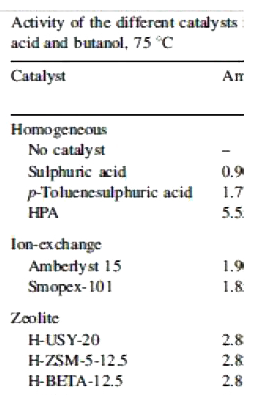
Here: kobs : observed reaction rate constant (m3mol−1s−1) kc catalysed reaction rate constant (m3mol−1g−1cats−1) Please note: k c = k obs/ amount (in g)
(source: PETERS, T., BENES, N., HOLMEN, A., & KEURENTJES, J. (2006). Comparison of commercial solid acid catalysts for the esterification of acetic acid with butanol. Applied Catalysis A: General, 297(2), 182-188. doi:10.1016/j.apcata.2005.09.00)
The weight-based activity of the heterogeneous catalysts tested decreases in the following order:View SolutionRead the passage given below and answer the question:
Industrially widely applied esterification reactions are commonly catalysed using mineral liquid acids, such as sulphuric acid and p-toluenesulphonic acid. The catalytic activity of homogeneous catalysts is high. They suffer, however, from several drawbacks, such as their corrosive nature, the existence of side reactions, and the fact that the catalyst cannot be easily separated from the reaction mixture. The use of solid acid catalysts offers an alternative and has received a lot of attention in the past years. Solid acid catalysts are not corrosive and, coated onto a support, they can be easily reused. Examples of solid acid catalysts used in esterification reactions include ion-exchange resins, zeolites and superacids like sulphated zirconia and niobium acid. Ion-exchange resins are the most common heterogeneous catalysts used and have proven to be effective in liquid phase esterification and etherification reactions. Because of their selective adsorption of reactants and swelling nature, these resins not only catalyse the esterification reaction but also affect the equilibrium conversion. Shortcomings include insufficient thermal resistance, which limits the reaction temperature to 120∘C, preventing widespread use in industry. Zeolites, like Y, X, BEA, ZSM-5 and MCM 41 offer an interesting alternative and have proven to be efficient catalysts for esterification reactions. Zeolites have found wide application in oil refining, petrochemistry and in the production of fine chemicals. Their success is based on the possibility to prepare zeolites with strong Brønsted acidity that can be controlled within a certain range, combined with a good resistance to high reaction temperatures.
In this study, the activity of various commercial available solid acid catalysts is assessed with respect to the esterification of acetic acid with butanol. The ion-exchange resins Amberlyst 15 and Smopex-101, the acid zeolites H-ZSM-5, H-MOR, H-BETA and H-USY, and the solid superacids sulphated zirconia and niobium acid are selected. Comparative esterification experiments have been carried out using the homogeneous catalysts sulphuric acid, p toluenesulphuric acid and a heteropolyacid (HPA). The weight-based activity of the heterogeneous catalysts tested is maximum for Smopex 101. The following table gives the activity of different catalysts in the esterification reaction between acetic acid and butanol at 75∘C.
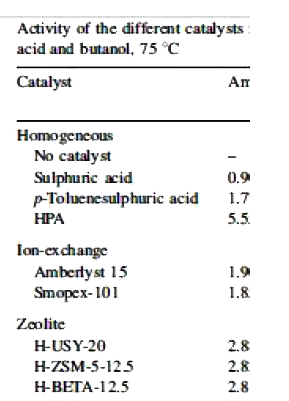
Here: kobs : observed reaction rate constant (m3mol−1s−1) kc catalysed reaction rate constant (m3mol−1g−1cats−1) Please note: k c = k obs/ amount (in g)
(source: PETERS, T., BENES, N., HOLMEN, A., & KEURENTJES, J. (2006). Comparison of commercial solid acid catalysts for the esterification of acetic acid with butanol. Applied Catalysis A: General, 297(2), 182-188. doi:10.1016/j.apcata.2005.09.00)
The catalytic activity of homogeneous catalysts is high. The weight based activity of HPA is less than which of the following heterogenous catalysts?View SolutionRead the passage given below and answer the question:
Industrially widely applied esterification reactions are commonly catalysed using mineral liquid acids, such as sulphuric acid and p-toluenesulphonic acid. The catalytic activity of homogeneous catalysts is high. They suffer, however, from several drawbacks, such as their corrosive nature, the existence of side reactions, and the fact that the catalyst cannot be easily separated from the reaction mixture. The use of solid acid catalysts offers an alternative and has received a lot of attention in the past years. Solid acid catalysts are not corrosive and, coated onto a support, they can be easily reused. Examples of solid acid catalysts used in esterification reactions include ion-exchange resins, zeolites and superacids like sulphated zirconia and niobium acid. Ion-exchange resins are the most common heterogeneous catalysts used and have proven to be effective in liquid phase esterification and etherification reactions. Because of their selective adsorption of reactants and swelling nature, these resins not only catalyse the esterification reaction but also affect the equilibrium conversion. Shortcomings include insufficient thermal resistance, which limits the reaction temperature to 120∘C, preventing widespread use in industry. Zeolites, like Y, X, BEA, ZSM-5 and MCM 41 offer an interesting alternative and have proven to be efficient catalysts for esterification reactions. Zeolites have found wide application in oil refining, petrochemistry and in the production of fine chemicals. Their success is based on the possibility to prepare zeolites with strong Brønsted acidity that can be controlled within a certain range, combined with a good resistance to high reaction temperatures.
In this study, the activity of various commercial available solid acid catalysts is assessed with respect to the esterification of acetic acid with butanol. The ion-exchange resins Amberlyst 15 and Smopex-101, the acid zeolites H-ZSM-5, H-MOR, H-BETA and H-USY, and the solid superacids sulphated zirconia and niobium acid are selected. Comparative esterification experiments have been carried out using the homogeneous catalysts sulphuric acid, p toluenesulphuric acid and a heteropolyacid (HPA). The weight-based activity of the heterogeneous catalysts tested is maximum for Smopex 101. The following table gives the activity of different catalysts in the esterification reaction between acetic acid and butanol at 75∘C.

Here: kobs : observed reaction rate constant (m3mol−1s−1) kc catalysed reaction rate constant (m3mol−1g−1cats−1) Please note: k c = k obs/ amount (in g)
(source: PETERS, T., BENES, N., HOLMEN, A., & KEURENTJES, J. (2006). Comparison of commercial solid acid catalysts for the esterification of acetic acid with butanol. Applied Catalysis A: General, 297(2), 182-188. doi:10.1016/j.apcata.2005.09.00)
Unit for observed rate constant for esterification reaction is m³ mol^-1s^-1, so the reaction is:View SolutionIn this type of question, a statement is given followed by two courses of action numbers I and II. The candidate is required to graph the statement, analyse the problem or policy it mentions and then decide which of the courses of action logically follow(s).
Statement A large cache of live ammunition has been found in the scrapyard of a local steel factory.
Courses of action I. The steel factory should immediately be closed down till all these ammunitions are located and shifted to safe places.
II. The Government should immediately set up an enquiry to unearth the details and take corrective measures to avoid such incidence in future.View SolutionThe activity of a catalyst has been explained in terms of spontaneous adsorption of reactant moleculse on the surface of catlyst and ther by forming an activated adsorbed complex along with evolution of heat . The adorbed activated complex undergoes to decompositio to regencerate catlyst and give products . adorpton is of two types :
(i) Physical adsorptio due to van der Waal's forces of attraction between reactant and catalyst molecules , weak , less exothermic, mulitlay and non-dirctional .
(ii) Chemical dasorpton due to free valencies , strong, more exothermic, unilayer. The extent of adormpotion (x/m) vs temperature at constant pressure gives isobars. Freundilish studied influence of pressure on the phusical adorptons and reported that log xmlogK+1nlogP.
During adorption of reactant momecules on catalyst surface :View Solution

